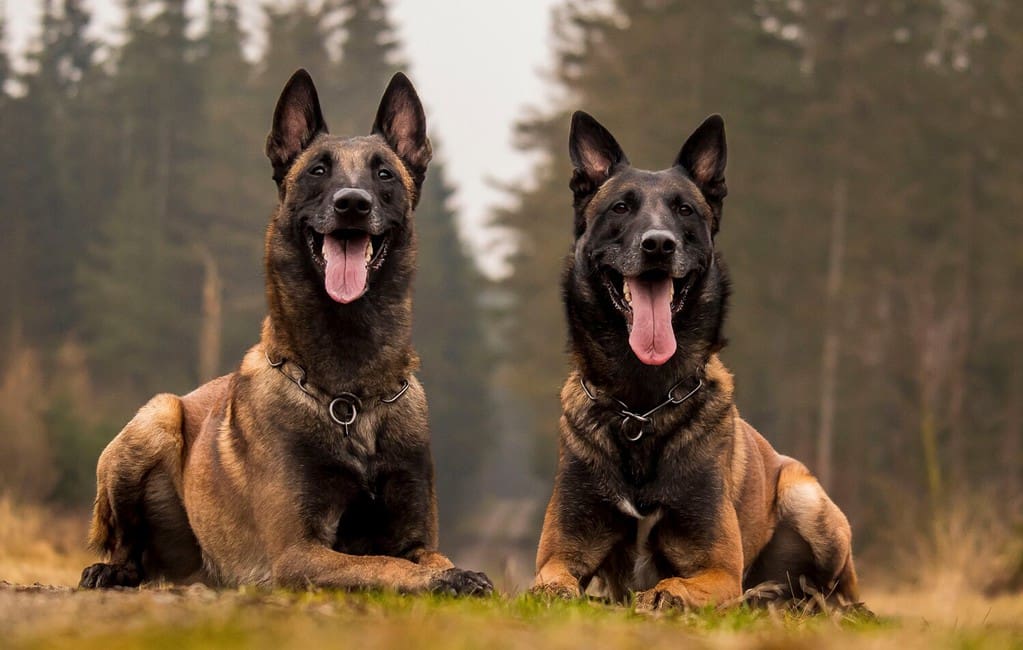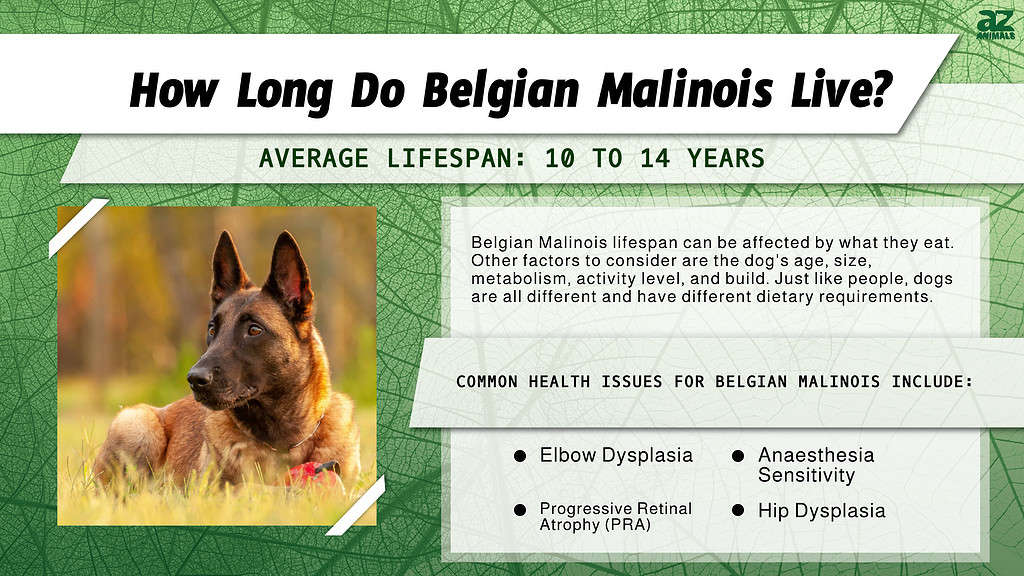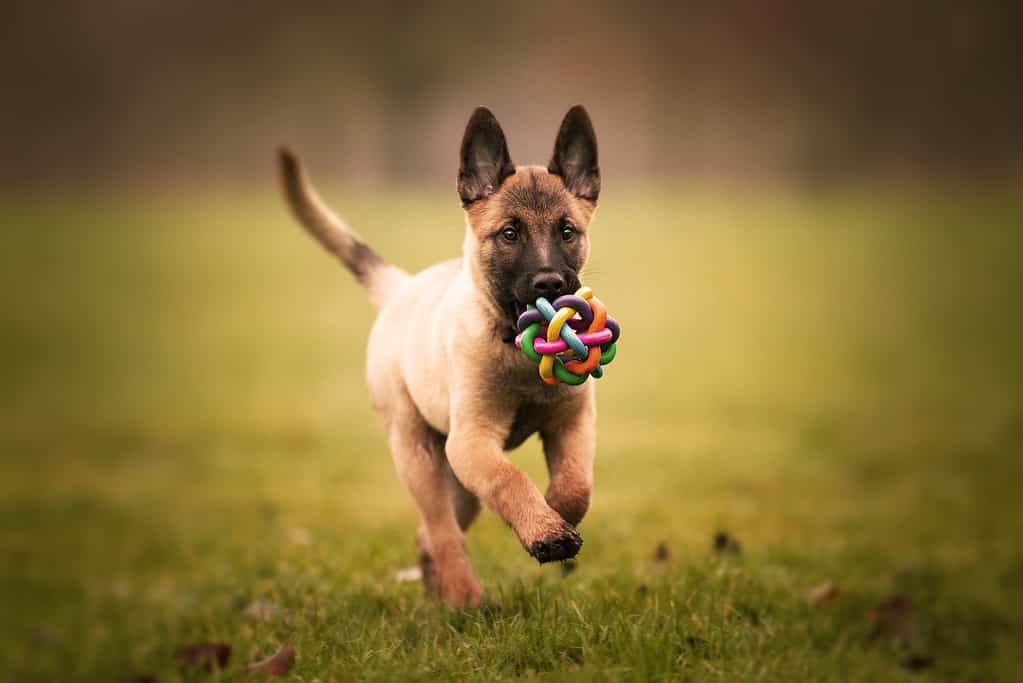The Belgian Malinois is known for its herding instincts, work ethic, and loyal nature. They are sometimes mistaken for German shepherds, but they are a different breed completely. Belgian Malinois are lighter and smaller and have shorter coats. Also, they crave physical activity as they are high-energy dogs. Therefore, they need regular physical and mental stimulation.
These dogs are in their element when walking, running, playing, and involved in any physical activity. Belgian Malinois lifespan is between 10 to 14 years. This breed is people-oriented and makes the perfect family dog, as they love being around people. They do, however, shed quite heavily twice a year. In addition, they are not recommended for apartment living but can adjust to it if given enough exercise. Lastly, they are highly intelligent and high-energy and are not advised for inexperienced dog owners.
Belgian Malinois Lifespan
This energetic and athletic dog is generally healthy. Therefore, Belgian Malinois have a reasonable lifespan of 10 to 14 years. Factors that can influence their lifespan include:
- Genetics
- Lifestyle
- Diet
- Exercise
- Regular vet visits

This energetic and athletic dog is generally healthy. Therefore, Belgian Malinois have a reasonable lifespan of 10 to 14 years.
©Benjaminj88/Shutterstock.com
Belgian Malinois Diet
Belgian Malinois lifespan can be affected by what they eat. This breed should get two to three cups of good-quality dog food twice daily. Other factors to consider are the dog’s age, size, metabolism, activity level, and build. Just like people, dogs are all different and have different dietary requirements. A very active dog will require more food than one that lays around the whole day.
Additionally, food quality makes a huge difference in nourishing a dog; the better the quality, the better it is for the dog. One thing to be careful of is overfeeding your dog, as it is not good for a dog to be overweight because it affects its bones and organs. Dog food packages usually have suggested amounts per pound, but you can always ask your local vet for clarification.
Belgian Malinois Health Conditions
This breed is generally very healthy. However, there are a few conditions to look out for. That is not to say that all Belgian Malinois will get these, but it is possible.
- Elbow Dysplasia: a hereditary condition that occurs in big dog breeds. This happens when the elbow joint does not fit properly into the socket. It can result in pain and lameness. It is manageable with medical and surgery.
- Anaesthesia Sensitivity: These dogs are highly sensitive to anesthesia because of their muscle-to-fat ratio. Unfortunately, they have a high rate of death when put under anesthesia.
- Progressive Retinal Atrophy (PRA): A degenerative eye disorder that causes blindness as the photoreceptors at the back of the eye degenerate.
- Hip Dysplasia: the same as elbow dysplasia. It is when the hip joint does not fit properly into the socket. This causes pain or even lameness in one or both back legs. Hip dysplasia is also hereditary. Some dogs will not display any symptoms for a long time. This condition can be confirmed by x-rays and treated or managed with pain medication or surgery.

Belgian Malinois Temperament
As Belgian Malinois progress, they become playful and curious, like all puppies. However, they will be affectionate with family members, but they are initially reserved towards strangers. This breed is a tireless working dog with outstanding watchdog abilities. In addition, they will protect their people and property with everything in them.
Belgian Malinois show a wide range of temperaments, and many different factors influence their temperament. Some of these factors include socialization, training, and genetics. Belgian Malinois needs early socialization. This includes exposure to numerous sounds, smells, experiences, and people from a young age. Socialization is great because it results in a more well-rounded dog. Some things that owners can do to help this process are taking their dogs to busy dog parks and enrolling them in a puppy class.
Beyond socialization, the aggressiveness of Belgian Malinois can vary between dogs. With that, along with some of the other needs the breed has, Belgian Malinois are most suited to experienced dog parents.
Belgian Malinois Trainability
A Belgian Malinois is relatively easy to train because of its intelligence and willingness to please its humans. Additionally, as herding dogs, they were bred to work well with humans and will help in the training process as long as the trainer is consistent and uses positive reinforcement.
This breed is very popular in obedience competitions, such as Schutzhund, a canine sport emphasizing tracking ability, obedience, and protection. Also, they excel in dog agility in other dog sports due to their athleticism and high trainability. Lastly, Belgian Malinois are also sought after in search-and-rescue work in the military and even in the war against rhino poaching in Africa.
Belgian Malinois Care
These agile dogs require some space but can do well in small quarters if they get sufficient exercise. Also, they prefer colder climates but can adapt to warmer temperatures if necessary. They need lots of love and affection and thrive in busy families, but they should be inside dogs. Furthermore, if possible, they should be given some off-leash exercise, like in a fenced area. They require at least 20 minutes of activity three or four times throughout the day. However, a leisurely stroll will not satisfy their appetite for exercise. They are the type of dogs that will be in their element, hiking or jogging with their owners.
Caring for Puppies
When they are puppies, their exercise needs will be different. Puppy school is an excellent way to exercise when they are between nine weeks and about four months old. Then, training, socialization, and 15 to 20 minutes of playtime in the morning and evening is advised. Also, throwing a ball for them will be sufficient. When they reach four to six months, daily half-mile walks and playtime in a fenced-in area or yard will meet their needs.
From the age of one year, they will need at least 40 minutes of physical activity each day, whether walking, jogging, or playing. This should be done in the morning or evening, not in the day’s heat. However, after the age of one, they will be ready to start jogging with their owners. Physical activity is a great way to keep your Belgian Malinois in good health, and it is good for their joints and bones. Try to avoid walking or hogging on hard surfaces and give them regular breaks. It is also a good idea to start with short distances and gradually increase them. Belgian Malinois should be given two meals daily and groomed at least once a week to avoid shedding.

When they are puppies, their exercise needs will be different. Puppy school is an excellent way to exercise when they are between nine weeks and about four months old.
©Wirestock/ via Getty Images
Is Belgian Malinois Good with Children?
If a Belgian Malinois is well-socialized, they should be fine with children. Also, if they are brought up with them, there shouldn’t be a problem. However, because of their herding background, they might try to herd them or nip at their heels when playing. As these dogs are trainable, teaching them not to do this is advised.
If a Belgian Malinois has not been raised with children, they should not join a household with small children. Children should also be taught how to approach and treat a dog without being left unsupervised with an unknown dog. Additionally, children should never be allowed to pull a dog’s tail, sit, or jump on them. It is a good idea to teach children not to approach a dog while eating or try to remove the dog’s food. Furthermore, Belgian Malinois may be aggressive towards other dogs or cats unless they have been brought up together.
Belgian Malinois Grooming
These dogs have straight and short hair that is “hard.” Their topcoat and thick undercoat are weather-resistant as they were bred to work outdoors. Furthermore, their coat is easy to groom. These dogs should be brushed once a week with a brush with firm bristles. This breed will shed year-round, but more so in fall and spring.
Also, their teeth should be brushed twice to thrice weekly to preserve dental health. Lastly, their nails should be trimmed regularly to avoid scratching of furniture or people. Belgian Malinois lifespan is better than average. Therefore, you will groom your dog for a good few years, and it should be a good experience for both the dog and the owner. Consequently, getting them used to it from a young age is advisable. Grooming can be a wonderful bonding experience.
The photo featured at the top of this post is © Wirestock/ via Getty Images
Ready to discover the top 10 cutest dog breeds in the entire world?
How about the fastest dogs, the largest dogs and those that are -- quite frankly -- just the kindest dogs on the planet? Each day, AZ Animals sends out lists just like this to our thousands of email subscribers. And the best part? It's FREE. Join today by entering your email below.
Thank you for reading! Have some feedback for us? Contact the AZ Animals editorial team.







